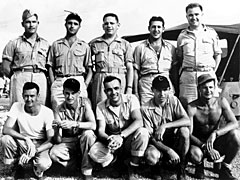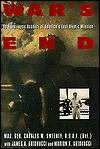Hiroshima & Nagasaki Remembered
60 years later
The Story of Nagasaki
The Missions
From the beginning the mission that resulted in the atomic bombing of Hiroshima overshadowed Nagasaki.
The Target Committee at Los Alamos selected Hiroshima as one of five possible targets for the first mission, along with Yokohama, Kokura, Niigata, and the city of temples, Kyoto (which was subsequently eliminated at the insistence of Secretary of War Henry L. Stimson against the advice of General Groves, the Manhattan Project's military leader).
When a second mission was approved, Kokura was the primary target Nagasaki was the secondary target.
The Hiroshima mission went off smoothly. On August 6, 1945, The Enola Gay lifted off from Tinian Island in the Northern Marianas at two A.M. The flight was uneventful, the weather cooperated, and, at 8:15 A.M. bombardier Major Thomas W. Ferebee released Little Boy. The Enola Gay landed uneventfully at Tinian. The crew was greeted by an excited crowd. Generals Carl A. "Tooey" Spaatz and Curtis E. LeMay had flown in from Guam. Pilot Paul W. Tibbets, Jr. was awarded the Distinguished Service Cross by General Spaatz. Following the ceremony the fliers were feted at a star-studded debriefing where General LeMay told the men, "Kids, go eat, take a good shower, and sleep as much as you want!"
The Nagasaki mission couldn't have been more different.
Originally scheduled for August 11, 1945, the mission was advanced to August 9 due to weather concerns. That day, when one would have expected all attention to be focused on the Nagasaki strike, yet another ceremony took place to honor Tibbets and the crew of the Enola Gay.
There was some confusion at the outset of the Nagasaki mission. Major Charles W. Sweeny was to command the mission in his plane The Great Artiste. But The Great Artiste was still outfitted with scientific gear left over from being the support plane for the Hiroshima mission and there wasn't time to outfit it to carry Fat Man. So Sweeney and his crew took over Captain Frederick C. Bock, Jr.'s plane Bock's Car, while Bock's crew switched to The Great Artiste.
A typhoon was threatening Iwo Jima, the mission rendezvous point. Yakushima, off the Kyushu coast, became the new rendezvous point and four B-29's were deployed as rescue planes in case crews needed to ditch over water.
Just before takeoff from Tinian, flight engineer Master Sergeant John D. Kuharek discovered that one of the fuel pumps was not operating, effectively cutting Bock's Car's fuel supply by 640 gallons. This could jeopardize a safe return and under other circumstances would have meant canceling the mission. But, to convince the Japanese that Hiroshima was not a one-time occurrence, it was decided to proceed.
Fat Man was aptly named. Bock's Car was overloaded by the heavy bomb. The plane lumbered down the runway. Everyone on Tinian had seen B-29s overloaded with mines and explosives crash and explode at the end of the runway when just one engine failed. The crew must have had this on their minds. Finally, at 1:56 A.M. on August 9, 1945, with scant yards of runway left, Bock's Car lifted off.
Dr. Robert Serber, Los Alamos physicist and J. Robert Oppenheimer's right hand man (Serber briefed physicists of the Manhattan Project on how to build an atomic bomb), was assigned as the mission's high-speed camera specialist. He was supposed to be in Major James T. Hopkins's support plane The Big Stink, but was scratched from the mission because he had forgotten his parachute. Radio silence had to be broken to instruct Hopkins on how to operate the camera.
While the two weather planes, Up an' Atom and Laggin' Dragon, were reporting favorable conditions over both Kokura and Nagasaki, Bock's Car was the scene of a heart-stopping discovery: the red arming light on the black box connected to Fat Man was lit, indicating that the firing circuit had closed. A half hour later weaponeer Captain Frederick L. Ashworth and his assistant 2nd Lieutenant Phillip M. Barnes had isolated the failed switch that had caused the malfunction and corrected the problem.
Bock's Car and The Great Artiste rendezvoused at Yakushima and waited for Hopkins's plane. Bock, aboard The Great Artiste, caught a glimpse of it, but Sweeney never saw the plane and circled the area for forty minutes, wasting yet more precious fuel, before finally taking off for Kokura.
Sweeney and his crew were under orders to only bomb visually. When they got to Kokura they found the haze and smoke obscuring the city as well as the large ammunition arsenal that was the reason for targeting the city. They made three unsuccessful passes, wasting more fuel, while anti-aircraft fire zeroed in on them and Japanese fighter planes began to climb toward them. The B-29s broke off and headed for Nagasaki. The phrase Kokura's Luck was coined in Japan to describe escaping a terrible occurrence without being aware of the danger.

